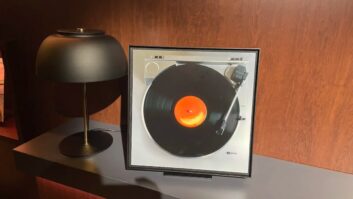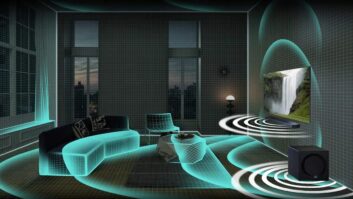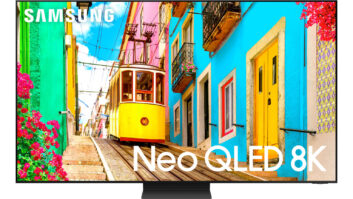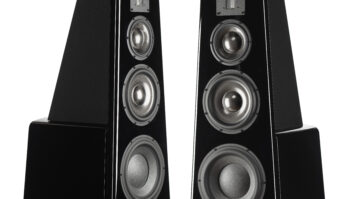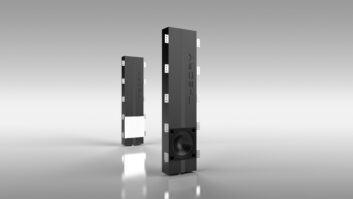Samsung unveiled its first iPod-docking audio system, first DVD-equipped shelf system and a receiver-based HTiB with HDMI 1.3 input for connection to high-definition disc players.
In its latest trio of high-definition Blu-ray players due in the fall, the company incorporated HDMI 1.3 and decoders for almost all mandatory and optional Blu-ray surround codecs, including Dolby TrueHD and DTS-HD High Resolution Audio but not losslessly compressed DTS-HD Master Audio.
The players stream the surround tracks in native form over HDMI 1.3 outputs to compatible decoders embedded in such products as A/V receivers. Samsung’s currently available P1200 Blu-ray player, in contrast, lacks Dolby TrueHD and DTS-HD decoding but incorporates Dolby Digital Plus, Dolby Digital, DTS and PCM decoding. It also features HDMI 1.3 output.
The HTiB with HDMI 1.3 input is the HT-AS720, expected to ship in October at $599 street price. Features include two HDMI-CEC inputs, one HDMI output, and 1080p pass-through from a connected Blu-ray player to a connected 1080p-capable high-definition display. HDMI simplifies the operation of multiple compatible components in a home theater system.
The AS720 also features onboard decoders for Dolby Digital, DTS, Dolby Digital Plus and multichannel PCM. Dolby TrueHD and DTS-HD High Resolution soundtracks can be converted by Samsung Blu-ray players to multichannel PCM for transport to the AS720 over HDMI cable, the company said.
The AS720, rated at 6×100 watts plus 150 watts in the powered subwoofer, comes with wall-mountable speakers. It doesn’t up-scale other video sources to high definition or feature XM Satellite Radio controls.
The company’s first DVD-equipped 2.1-channel shelf system is the MAX-DX76 ($349 street price), which ships in October with component and HDMI outputs and 350-watt amplification. Its vertical piano-black chassis features blue accent lights and rounded edges. It’s equipped with Dolby Digital and DTS decoders but not with virtual surround technology that delivers surround sound through two speakers. It also doesn’t upscale video to high-definition.
The brand’s first iPod-docking audio system is the one-piece MM-X5 ($179 street price), which also features USB Host to connect to, and play back content from, USB drives and USB-equipped MP3 players. The unit, which is officially called an “MP3 player docking microcomponent,” features integrated iPod dock, FM radio, CD slot, clock-radio functions, built-in MP3 decoder to play MP3 files embedded on CDs and in USB drives, 2×10-watt output and single-driver speakers.
The company recently shipped a trio of 70 Series HTiBs without dedicated iPod dock but with USB host capability. They are priced from a suggested $379 to $509.
The new audio systems and Blu-ray players sport gloss piano black finish to match the cosmetics of Samsung’s HDTVs.
In headphone MP3 players, the company plans to expand its selection of models with light-emitting touchpad controls with the August shipment of an $89-suggested U3. The 2GB device plugs directly into a PC’s USB port without a cable and incorporates FM radio, voice recorder, OLED display, digital file storage, 15-hour battery and playback of MP3 and protected WMA music files. It’s due in five colors.
The U3 joins the 2GB and 4GB versions of the recently released K3 with light-emitting touchpad at a suggested $149 and $199, respectively. They offer the same music decoders as the U3 but add larger 1.8-inch color display, JPEG viewer and 25-hour battery. They’re also available in five colors.
Samsung also plans additional MP3 models later this year, but they won’t be accompanied by headphone stereos that play back live or recorded XM programming, said marketing VP Reid Sullivan. Though the discontinued XM headphone stereos were successful, Sullivan said, Samsung’s “extremely high” expectations had not been reached, in part because the devices were packaged with home docking stations, whereas most satellite radio listeners are listening in the car. In addition, the devices were displayed mainly in retailers’ MP3 departments, whereas another-brand model packaged with car dock was displayed in the car audio department, he noted.







